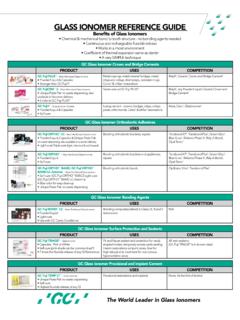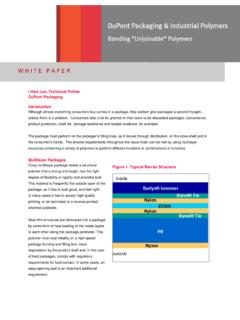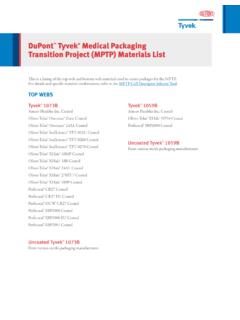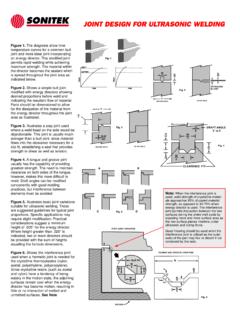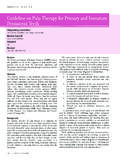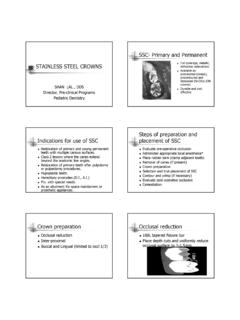Transcription of Elastic Modulus of Poly(ethylene-co-acrylic acid ...
1 Elastic Modulus of Poly(ethylene-co-acrylic acid ). Copolymers and Ionomers: Effects of Temperature and Relative Humidity Kathryn Alexis Laney May 2010. Advisor: Professor Jay B. Benziger Submitted in partial fulfillment of the requirements for the degree of Bachelor of Science in Engineering Department of Chemical Engineering Program in Sustainable Energy Princeton University This paper represents my own work in accordance with University regulations I authorize Princeton University to lend this thesis to other institutions or individuals for the purpose of scholarly research Kathryn Alexis Laney I further authorize Princeton University to reproduce this thesis by photocopying or by other means, in total or in part, at the request of other institutions or individuals for the purpose of scholarly research Kathryn Alexis Laney ii Princeton University requires the signatures of all persons using or photocopying this thesis.
2 Please sign below, and give address and date. iii To my family, who have supported me throughout it all iv All praise, honor and glory belong to my Lord and Savior who has sustained me throughout all of my journeys, including this thesis. I would like to thank all the members of the Benziger group for their guidance and support. I often found myself frustrated and their insight proved invaluable. I would like to acknowledge the McIntosh Senior Thesis funds for their generous support of this work. Lastly, I would like to thank my family and friends. Without their daily infusion of encouragement and love, I know I would not have been able to finish. Thanks! v Abstract The persulfonate ionomer Nafion is the preeminent membrane used in polymer electrolyte membrane fuel cell applications. Despite the extensive characterization of this polymer, there is still significant uncertainty concerning the interdependence of polymer morphology, mechanical behavior and environmental conditions.
3 In order to better understand the mechanical and transport properties of ionomers such as Nafion, the fundamental interactions between the hydrophobic and hydrophilic domains within such polymers needs to be clarified. In this work, the amphiphilic copolymer Poly(ethylene-co-acrylic acid ) PEAA is examined. Using a tensile testing apparatus that carefully controls both temperature and relative humidity, it is possible to ascertain the effect of environmental conditions on the Elastic Modulus of PEAA. In the acid form, the copolymer Modulus monotonically decreases with increasing temperature. However, there is no Modulus dependence on relative humidity. By neutralizing the acid group with a sodium cation, significant plasticization effects are observed. The difference in behavior of the acid and salt form of the polymer is attributed to differences in electrostatic interactions.
4 The energy associated with the solvation of the acrylic acid unit is insufficient to overcome the energy required to swell the polymer. This balance between the energy of solvation and swelling corresponds well with trends experienced in Nafion. The behavior of the copolymer sample highlights the importance of the strength of the electrostatic interactions on polymer morphology and mechanical behavior. vi Table of Contents Abstract .. vi Table of Contents .. vii List of Tables .. viii List of Figures .. ix Introduction .. 1. 2. Effect of Comonomer Content .. 3. Effect of Neutralization .. 4. Thermal Transitions .. 6. Water Sorption .. 7. Experimental Section .. 8. Materials .. 8. Film Preparation .. 9. Experimental 11. Instantaneous Elastic Modulus .. 12. Results and Discussion .. 14. In-situ Drying.
5 14. Swelling Dynamics .. 18. Elastic Modulus .. 22. Conclusion .. 31. Future Work .. 32. References .. 33. Appendix .. 35. Solvent Casting .. 35. Melting .. 36. vii List of Tables Table 1: Physical Properties of Poly(ethylene-co-acrylic acid ) copolymer .. 8. Table 2: Modulus measurements for application and removal of load .. 14. Table 3: Preliminary water sorption studies of copolymer samples .. 20. Table 4: Comparison of Elastic Modulus of Different acid Content Polymers .. 30. viii List of Figures Figure 1: Basic structure of Poly(ethylene-co-acrylic acid ) polymer .. 2. Figure 2: Dimer interaction in PEAA .. 4. Figure 3: Photographs of prepared PEAA films in petri dish molds ..10. Figure 4: Schematic of tensile testing apparatus..11. Figure 5: Strain response to cyclic stress during Elastic Modulus test.
6 13. Figure 6: Length of PEAA-20H sample during in-situ drying ..15. Figure 7: Length of PEAA-20Na sample during in-situ drying ..17. Figure 8: Equilibrium swelling curve for PEAA-20H and PEAA-20Na samples at 23 C, 10%RH and 90%RH ..19. Figure 9: Linear Expansion of PEAA-20Na+ ..21. Figure 10: Strain response of PEAA-20H from 23-66 C, 0%RH ..22. Figure 11: Instantaneous Elastic response of PEAA-20H from 23-66 C at 0% RH ..24. Figure 12: Elastic Modulus of PEAA-20H as a function of relative humidity and temperature ..25. Figure 13: Elastic Modulus of PEAA-20Na as a function of temperature and relative humidity ..27. Figure 14: Elastic Modulus of PEAA-5H as a function of temperature and relative humidity ..29. ix Introduction Nafion is the preeminent membrane used in polymer electrolyte membrane fuel cell applications.
7 This polymer is composed of a tetrafluoroethylene backbone with 1, 2. perfluoroalkyl ether grafts that are terminated in sulfonic acid groups. The interaction between the hydrophobic backbone and the hydrophilic pendant groups gives Nafion its unique characteristics. Though the polymer has undergone extensive characterization, there is no scientific consensus linking the polymer's structure to its mechanical and transport behavior. Multiple studies conducted by the Benziger group emphasize the influence of environmental conditions, such as temperature and water activity, on the polymer's properties. 2-4 By carefully controlling environmental conditions, these studies have begun to illuminate how temperature and relative humidity combine to influence the microstructural development of Nafion.
8 The examination of other amphiphilic copolymer systems is needed to further elucidate the fundamental interactions between environmental conditions, polymer morphology and mechanical behavior. The present work examines how the Elastic Modulus of simple poly ( ethylene -co- acrylic acid ) (PEAA) copolymers and ionomers changes with respect to temperature and water activity. The Elastic Modulus , a material's response to small strains, is considered one of the most basic mechanical properties. Furthermore, it has been shown that the Modulus affects equilibrium swelling and the absorption of water in Nafion and other ionomer Hence, it serves as a good starting point for understanding how the dynamics of microphase separation within Poly(ethylene-co-acrylic acid ) respond to environmental conditions.
9 By increasing the knowledge of the physics governing microstructure phase dynamics, it will be possible to better predict and control the performance of such amphiphilic polymers in their end-use applications. 1. Background Poly(ethylene-co-acrylic acid ) [PEAA] is a carboxylated ethylene copolymer . Primarily produced under the trade names of Nucrel, Surlyn and Primacor, it is synthesized 5-7. via the high pressure, free radical copolymerization of ethylene and acrylic acid . This process results in a highly branched polymer with random placement of the constituent monomers along the backbone. The branched structure of low density polyethylene has been well NMR studies have been used to verify that the hydrogen opposing the acrylic acid group is also subject to backbiting during polymerization, lending itself to branching as , 9.
10 The structure of the repeating unit of this random copolymer is depicted in Figure 1 below. Figure 1: Basic structure of Poly(ethylene-co-acrylic acid ) polymer The properties of PEAA copolymers depend strongly on the constituent monomers, ethylene and acrylic acid . ethylene is a common monomer found in many olefinic polymers. Furthermore, its ordered, symmetric structure allows it to crystallize under appropriate conditions. Composed of only carbon and hydrogen, polyethylene is hydrophobic in nature. While acrylic acid also has a backbone of carbon and hydrogen, the pendant carboxylic acid group enables this polymer to interact with water. However, its pKa value of indicates that the acid is relatively weak and only dissociates modestly. Thus while a driving force for separation exists between the ethylene and acrylic acid segments, it is relatively small.
